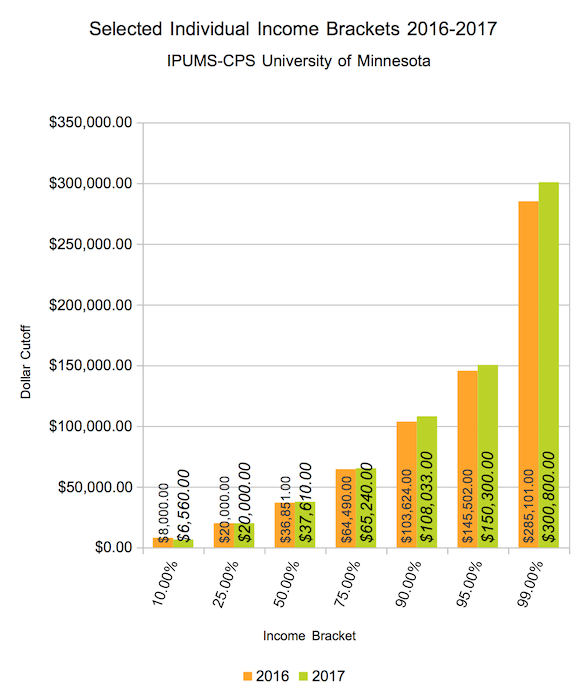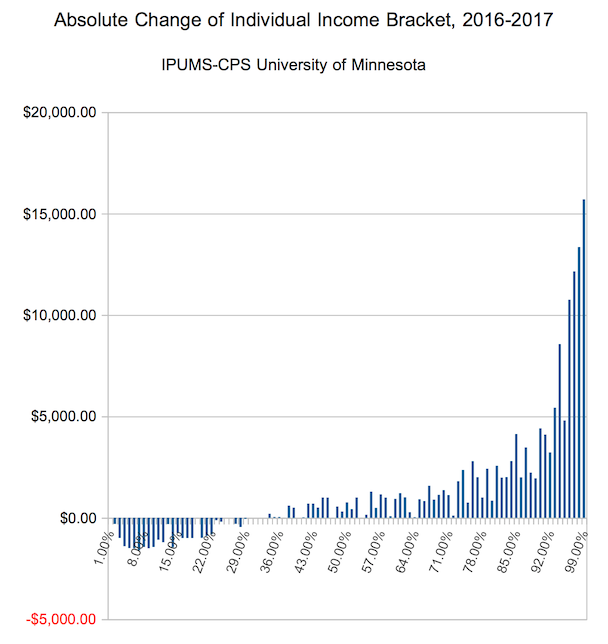In this post, we'll break down the United States Income Brackets for 2017. This data is for all individual income earners (see household income brackets elsewhere) who were part of the workforce at some point in the year 2016, between January and December. We also include a table of every income percentile for 2017 United States income data.
Selected United States Income Brackets for 2017 and 2016
Included here are selected income brackets for the United States for both 2016 and 2017 surveys. We've included the 10th, 25th, 50th (median), 75th, 90th, 95th and 99th income percentile. In this post, income is total income from all sources - you can find a list of all components here. (Note again that surveys are performed in March - numbers are for the full previous year.)
It's important to note that this data is not longitudinal; there are almost an additional 5,000,000 people represented in the 2017 workforce data. From year to year people often switch income brackets, and people are rarely (if ever) in the same percentile year after year. That in mind, we still can note the improvements in income across the board.
Even with the additional workers in the workforce, there was a huge improvement in incomes at most income levels. There certainly is some weakness in lower income brackets, but income gains came for ~ 60% or 70% of income percentiles.
Every Income Percentile for the United States in 2016
Using our workforce definition, here is every income percentile for individual income earners in full year 2016. Median individual income for all earners in the workforce was $37,610.00, and the breakpoint to be a one-percenter (99th percentile) was $300,800.00.
| Income Percentile | Earnings Breakpoint |
| 1% | $0.00 |
| 2% | $0.00 |
| 3% | $5.00 |
| 4% | $600.00 |
| 5% | $1,506.00 |
| 6% | $2,500.00 |
| 7% | $3,400.00 |
| 8% | $4,559.00 |
| 9% | $5,500.00 |
| 10% | $6,560.00 |
| 11% | $7,916.00 |
| 12% | $8,796.00 |
| 13% | $10,000.00 |
| 14% | $10,043.00 |
| 15% | $11,264.00 |
| 16% | $12,000.00 |
| 17% | $13,000.00 |
| 18% | $14,000.00 |
| 19% | $15,000.00 |
| 20% | $15,010.00 |
| 21% | $16,000.00 |
| 22% | $17,000.00 |
| 23% | $18,000.00 |
| 24% | $19,000.00 |
| 25% | $20,000.00 |
| 26% | $20,000.00 |
| 27% | $20,210.00 |
| 28% | $21,045.00 |
| 29% | $22,002.00 |
| 30% | $23,000.00 |
| 31% | $24,000.00 |
| 32% | $24,960.00 |
| 33% | $25,000.00 |
| 34% | $25,223.00 |
| 35% | $26,040.00 |
| 36% | $27,040.00 |
| 37% | $28,001.00 |
| 38% | $29,000.00 |
| 39% | $30,000.00 |
| 40% | $30,000.00 |
| 41% | $30,024.00 |
| 42% | $31,000.00 |
| 43% | $32,000.00 |
| 44% | $32,509.00 |
| 45% | $34,000.00 |
| 46% | $35,000.00 |
| 47% | $35,002.00 |
| 48% | $35,568.00 |
| 49% | $36,310.00 |
| 50% | $37,610.00 |
| 51% | $38,426.00 |
| 52% | $40,000.00 |
| 53% | $40,001.00 |
| 54% | $40,150.00 |
| 55% | $41,508.00 |
| 56% | $42,231.00 |
| 57% | $43,680.00 |
| 58% | $45,000.00 |
| 59% | $45,075.00 |
| 60% | $46,126.00 |
| 61% | $47,982.00 |
| 62% | $49,014.00 |
| 63% | $50,000.00 |
| 64% | $50,029.00 |
| 65% | $51,013.00 |
| 66% | $52,126.00 |
| 67% | $54,023.00 |
| 68% | $55,019.00 |
| 69% | $56,169.00 |
| 70% | $58,222.00 |
| 71% | $60,000.00 |
| 72% | $60,107.00 |
| 73% | $62,003.00 |
| 74% | $64,421.00 |
| 75% | $65,240.00 |
| 76% | $67,990.00 |
| 77% | $70,000.00 |
| 78% | $71,003.00 |
| 79% | $73,859.00 |
| 80% | $75,067.00 |
| 81% | $77,850.00 |
| 82% | $80,010.00 |
| 83% | $82,016.00 |
| 84% | $85,056.00 |
| 85% | $89,428.00 |
| 86% | $91,992.00 |
| 87% | $96,000.00 |
| 88% | $100,002.00 |
| 89% | $102,014.00 |
| 90% | $108,033.00 |
| 91% | $114,119.00 |
| 92% | $120,502.00 |
| 93% | $129,048.00 |
| 94% | $140,001.00 |
| 95% | $150,300.00 |
| 96% | $165,000.00 |
| 97% | $187,222.00 |
| 98% | $219,999.00 |
| 99% | $300,800.00 |
Methodology for the 2016 United States Income Brackets
Data originates in the United States Census Bureau's Annual ASEC survey, first released in September 2017. The University of Minnesota's Minnesota Population Center further harmonizes the data to be better comparable across years and variables:
Sarah Flood, Miriam King, Steven Ruggles, and J. Robert Warren. Integrated Public Use Microdata Series, Current Population Survey: Version 4.0. [dataset]. Minneapolis: University of Minnesota, 2015. http://doi.org/10.18128/D030.V4.0.
Who's Included in Your Workforce?
Our individual income posts always strive for a fair definition of 'workforce'. Screening out "non-workers" from the set is important to give a fair comparison of incomes in the United States, and we're happy with the screen we're using this year.
To count as a worker, we used this broad definition (IPUMS variable name in parenthesis):
- Reported working >= 1 hour per week (UHRSWORKT) OR
- Reported being in the workforce in 2016 (WORKLY) OR
- 'yes' wanted a job in 2016 (WANTJOB) OR
- 'maybe' wanted a job in 2016 (WANTJOB)
Running this screen on the 2017 dataset leaves 97,017 data points representing 172,303,704 Americans. For the 2016 dataset it leaves 94,537 and 167,736,100, respectively.
Conclusions on United States Income Brackets for 2017
All in all, 2016 was an excellent year for increasing incomes across the board. Adding up the incomes for the above populations, you'd get $9,294,424,583,388 in 2017 and $8,812,758,949,156 in 2016.
That's a nonsense stat, sure - but without changing our year over year measures that's a 5.466% increase in income earned by our definition of the workforce. That's in an era of negligible inflation to boot.
2016 was an excellent year for income gains, and a successful last full year under the economy of President Obama. Hopefully the prosperity continues under President Trump!
Anything interesting you see in the stats? Did you have a good year in 2016?


